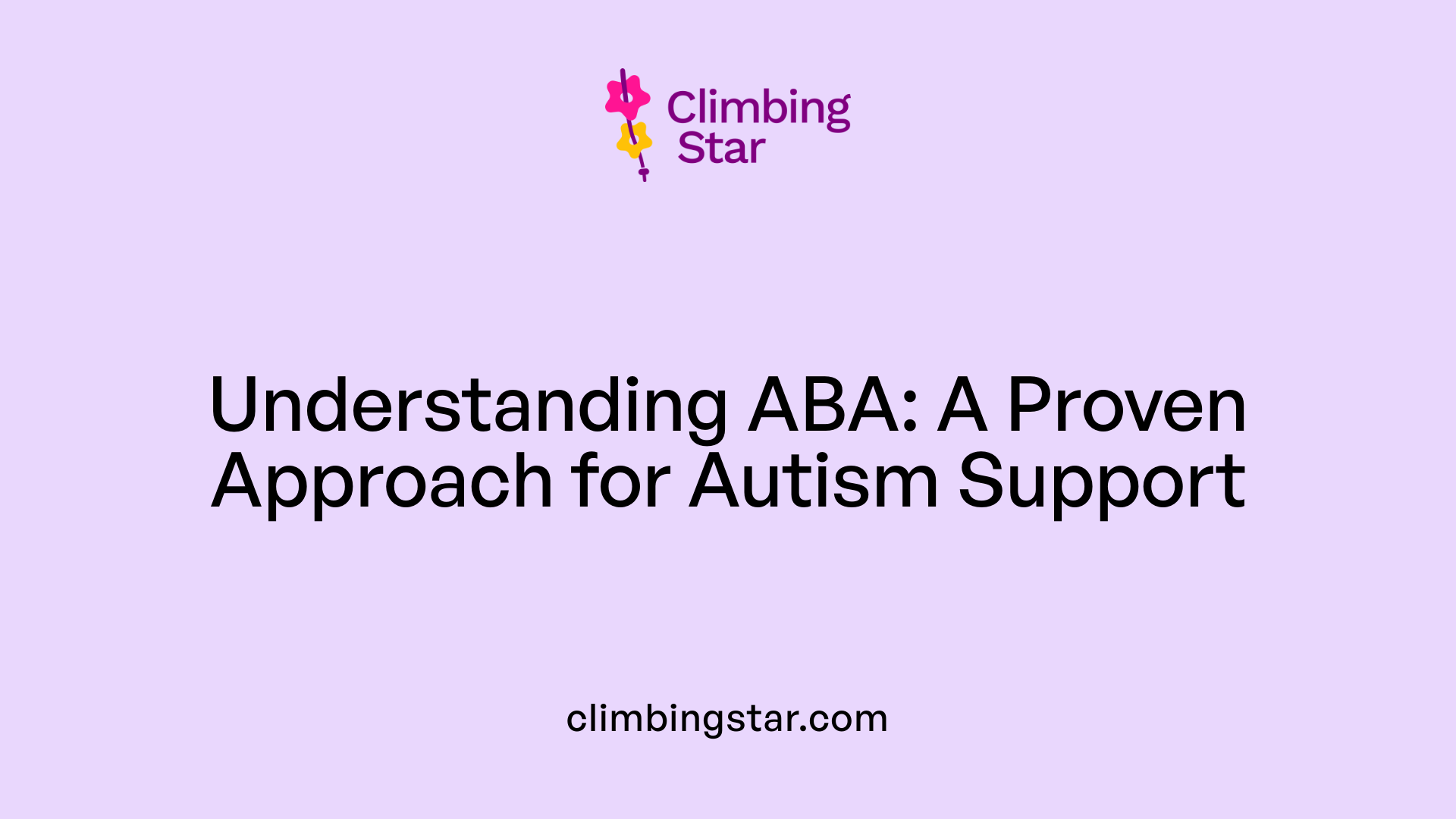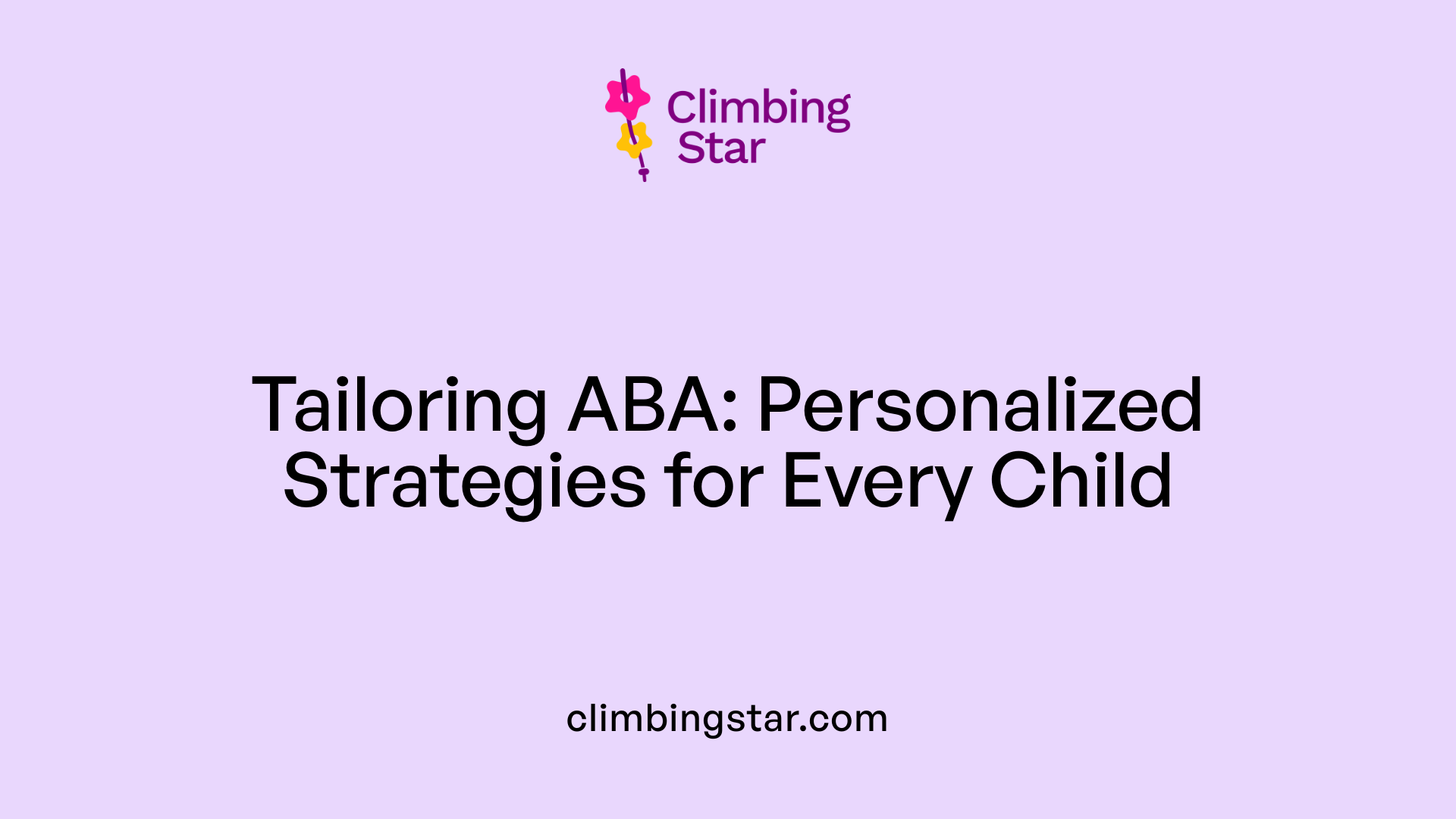Understanding Low-Functioning Autism and Intervention Approaches
Low-functioning autism presents unique challenges that impact communication, social interaction, and daily living skills. Addressing these challenges requires tailored interventions grounded in evidence-based practices. Among these, Applied Behavior Analysis (ABA) therapy has established itself as a leading approach to improve developmental outcomes. This article explores the nature of ABA therapy, its providers, effectiveness, customization, techniques, and considerations in its application, alongside other relevant therapeutic interventions to support individuals with low-functioning autism.
What is ABA Therapy and Its Role in Treating Low-Functioning Autism?

What is ABA therapy and how is it used in treating autism?
Applied Behavior Analysis (ABA) is a therapy grounded in the science of learning and behavior, designed to support individuals with autism in increasing helpful behaviors and reducing harmful ones. This approach uses techniques like positive reinforcement to reward desired behaviors, encouraging children to repeat those actions.
ABA therapy involves understanding the relationship between behavior and the environment. Through methods such as Discrete Trial Training (DTT) and Pivotal Response Treatment (PRT), therapists work to build skills in communication, social interaction, self-care, play, motor, and academic areas. These interventions often take place in natural settings, such as the home or school, allowing children to practice skills in everyday contexts.
What are the goals of ABA in autism treatment?
The primary aim of ABA programs is to promote independence and success by developing a broad range of skills. This includes enhancing expressive language and social skills, improving daily living abilities, and reducing behaviors that may interfere with learning or safety.
ABA therapy focuses on measurable goals, with progress tracked regularly through data collection and analysis. Adjustments are made based on this progress to ensure therapy remains tailored to the individual's growth and challenges.
How are ABA techniques applied and in what settings?
ABA techniques range from highly structured tasks like Discrete Trial Training, which breaks down skills into small, manageable steps, to more naturalistic methods such as Pivotal Response Treatment, which utilizes play and the child's interests. The Early Start Denver Model (ESDM) combines these approaches to address multiple developmental domains simultaneously.
Therapy sessions are usually conducted by Board Certified Behavior Analysts (BCBAs) and trained therapists or Registered Behavior Technicians (RBTs), often serving children between infancy and school age but adaptable for all ages.
Why is individualized programming important in ABA?
Each ABA program is personalized based on detailed assessments by a BCBA, identifying specific skill deficits and behavioral challenges. This customization ensures interventions meet the unique needs of each child, increasing the likelihood of meaningful gains.
Ongoing data collection and analysis guide these individualized plans, allowing therapists to refine goals and strategies continuously.
How is ABA recognized as an evidence-based practice?
ABA therapy is endorsed as a best practice by authoritative organizations, including the US Surgeon General and the American Psychological Association. Research consistently demonstrates that intensive ABA interventions, especially when started early and carried out intensively (e.g., 25-40 hours per week), lead to significant improvements in intellectual function, language, social skills, and daily living capabilities in children with autism.
This scientific foundation sets ABA apart as the most extensively validated behavioral treatment, making it a cornerstone approach for supporting individuals with low-functioning autism.
| Aspect | Description | Purpose/Effect in ABA Therapy |
|---|---|---|
| Positive Reinforcement | Rewarding desired behaviors | Increases likelihood of skill acquisition |
| Discrete Trial Training | Structured, step-by-step teaching | Builds foundational skills systematically |
| Pivotal Response Treatment | Child-led, play-based approach | Enhances motivation and natural learning |
| Individualized Assessment | Detailed evaluation by BCBA | Tailors therapy to specific needs |
| Evidence-Based Recognition | Endorsement by US Surgeon General & APA | Validates therapy's effectiveness |
Qualified Professionals Providing ABA Therapy

Role of Board Certified Behavior Analysts (BCBA)
Board Certified Behavior Analysts (BCBAs) serve as the lead professionals in ABA therapy. They hold graduate degrees and possess specialized training in behavior analysis and autism interventions. BCBAs conduct detailed assessments, design individualized treatment plans, set clear goals, and monitor progress through ongoing data collection. Their expertise ensures that interventions are evidence-based and tailored to each individual's needs.
Function of Registered Behavior Technicians (RBT)
Registered Behavior Technicians (RBTs) are paraprofessionals who implement ABA therapy under the direct supervision of a BCBA. They typically have a high school diploma and must complete specific training and certification requirements, including a competency assessment. RBTs engage directly with clients to perform therapy sessions, delivering interventions as designed in treatment plans.
Training and Certification Requirements
All ABA providers must meet rigorous training, education, and certification standards. BCBAs undergo graduate-level coursework followed by supervised practical experience and must pass a comprehensive certification exam. RBTs complete foundational training and hands-on competency evaluations. Additionally, Board Certified Assistant Behavior Analysts (BCaBAs), with undergraduate degrees and specific specialized coursework, support therapy delivery under BCBA oversight.
Team Approach in ABA Therapy Delivery
ABA therapy typically involves a coordinated team including BCBAs, RBTs, BCaBAs, and sometimes other specialists. The BCBA directs the therapeutic process, while RBTs and assistants carry out daily sessions. Collaborative efforts ensure consistent implementation, adjustment based on client progress, and comprehensive support.
Importance of Supervision and Standards
Continuous supervision by BCBAs is essential to maintain high standards and ethical practice in ABA therapy. They provide guidance, ongoing training, and quality assurance, ensuring interventions are delivered safely and effectively. State licensing and certification bodies regulate provider qualifications, emphasizing professional competence and accountability.
| Provider Role | Education Level | Certification & Training |
|---|---|---|
| Board Certified Behavior Analyst (BCBA) | Graduate degree (Master’s or higher) | Graduate coursework, supervised experience, certification exam |
| Registered Behavior Technician (RBT) | High school diploma | Training course, competency assessment, certification |
| Board Certified Assistant Behavior Analyst (BCaBA) | Undergraduate degree | Specialized coursework, supervised experience, certification |
Collectively, this team of qualified professionals ensures that ABA therapy is delivered with expertise, care, and adherence to the best clinical standards.
Scientific Evidence Supporting ABA Therapy Outcomes
What evidence supports the effectiveness of ABA therapy for individuals with autism?
Applied Behavior Analysis (ABA) therapy has a strong research foundation supporting its effectiveness for individuals with autism spectrum disorder (ASD). Numerous studies and meta-analyses demonstrate that ABA yields significant improvements in core developmental areas.
Research findings on ABA effectiveness
Research shows that ABA interventions produce moderate to large gains in intellectual functioning, communication skills, language development, and socialization. Comprehensive ABA programs, especially those intensive and early-start, have positive impacts on children's developmental trajectories. For example, a meta-analysis of 29 studies found effect sizes indicating moderate to high benefits for IQ improvements (effect size g=0.740), expressive language skills (g=0.742), receptive language skills (g=0.597), and communication skills (g=0.650).
Improvements in communication and social skills
ABA therapy strongly supports social skills and communication development. The method encourages repetition and reinforcement, aiding children in acquiring new expressive language and social interaction abilities. Social responsiveness also improves with social skills training as part of ABA programs, contributing to better peer interactions and emotional wellbeing.
Effect sizes in IQ and adaptive behavior
Beyond language, ABA has moderate effectiveness in improving adaptive behaviors such as daily living skills and socialization (effect sizes around g=0.422 to 0.444). Although gains in daily living skills like self-care are generally lower (g=0.138), the growth in adaptive functioning supports greater independence over time.
Impact on low-functioning individuals
Children with lower initial adaptive functioning tend to demonstrate greater developmental gains with ABA therapy. This suggests ABA is beneficial even for those classified as low-functioning or with more severe challenges, highlighting its role in helping a broad spectrum of individuals with ASD.
Limitations in treatment adherence and future research needs
Despite these positive findings, treatment adherence and intensity can limit outcomes. Studies report that only approximately 28% of children receive the recommended full dosage of therapy hours, which may affect overall effectiveness. Additionally, many ABA studies face challenges such as small sample sizes and lack of long-term follow-up data, underscoring the need for larger, prospective research assessing quality of life and lasting benefits.
| Aspect | Effectiveness Level | Specifics |
|---|---|---|
| IQ Improvement | Moderate to high (g=0.740) | Significant IQ gains observed in well-structured programs |
| Expressive Language | Moderate to high (g=0.742) | Enhanced speech and communication skills |
| Receptive Language | Moderate (g=0.597) | Improved language comprehension |
| Communication Skills | Moderate (g=0.650) | Better social interaction abilities |
| Adaptive Behavior | Moderate (g=0.422) | Daily living and socialization improvements |
| Daily Living Skills | Low (g=0.138) | Minimal gains in self-care and related tasks |
In summary, ABA therapy’s scientific evidence underscores its value as a leading intervention for autism. While effective especially with early intensive interventions, ongoing research and improved treatment adherence are essential for maximizing benefits across diverse populations.
Personalizing ABA Therapy to Individual Needs

Can ABA therapy be customized to individual needs?
Yes, Applied Behavior Analysis (ABA) therapy is highly customizable to fit the unique needs of each individual with autism. It begins with a detailed assessment conducted by a Board Certified Behavior Analyst (BCBA), who identifies specific behaviors to increase or decrease based on how those behaviors are influenced by the person's environment.
Assessment and goal-setting processes
The process involves an in-depth evaluation of the individual's skills, challenges, and daily environment. This assessment helps to set precise, measurable goals that promote independence and enhance communication, social skills, self-care, and academic abilities. Goals are personalized to suit the person’s developmental level and family priorities.
Focus on environmental influences on behavior
ABA views behavior as directly affected by environmental factors. Therapists analyze antecedents (what happens before a behavior) and consequences (what happens after) to understand triggers and reinforcements. This allows interventions to be designed that modify the environment to encourage positive behaviors and reduce negative ones.
Adapting techniques to individual strengths
Therapists tailor ABA techniques such as positive reinforcement, prompting, and behavior chaining to match the individual's learning style and strengths. For example, some may respond better to naturalistic reinforcement during play, while others benefit from structured tasks. Flexibility allows the therapy to be engaging and effective.
Continuous data collection and progress monitoring
Data collection is fundamental in ABA, with therapists systematically recording responses and behavioral changes over time. This ongoing monitoring helps to adjust the intervention plan promptly, ensuring that it remains effective and relevant to the individual's evolving needs.
Maximizing meaningful and functional outcomes
By personalizing ABA therapy based on comprehensive assessments and environmental understanding, the interventions aim not only to improve specific skills but to support meaningful, functional independence in real-world settings. This approach maximizes the potential for success across communication, social interactions, daily living, and learning domains.
Core Techniques Employed in ABA Therapy

What are some common techniques used in ABA therapy?
Applied Behavior Analysis (ABA) therapy employs several structured techniques designed to encourage positive behavior change and skill development. Among them, Discrete Trial Training (DTT) stands out as a highly structured method involving one-on-one sessions where tasks are broken down into small, manageable steps. Each trial has a clear beginning and end, and behaviors are taught through repetition with prompts and reinforcement.
Another widely used approach is Pivotal Response Treatment (PRT), which is less structured and focuses on the child’s interests and natural motivation. PRT aims to improve pivotal areas like communication, social interaction, and play by incorporating natural reinforcement and encouraging self-initiation.
Natural Environment Teaching (NET) embeds learning opportunities within everyday activities and surroundings, promoting skill generalization and spontaneous social communication. NET uses the child's natural interests to make teaching moments meaningful and contextually relevant.
Reinforcement strategies are central to ABA. Positive reinforcement rewards desired behaviors, increasing their frequency, whereas negative reinforcement involves the removal of unpleasant stimuli when a behavior occurs. Prompting techniques—using cues or assistance—help initiate desired responses, while fading gradually reduces help to promote independence.
Behavior analysis often uses the Antecedent-Behavior-Consequence (ABC) model to understand how environmental factors influence behavior. Functional Communication Training (FCT) replaces challenging behaviors with purposeful communication, teaching individuals to express needs effectively.
These varied methods work in tandem to build communication, social, and daily living skills while reducing harmful or disruptive behaviors, making ABA a comprehensive and adaptable therapy for individuals with Autism Spectrum Disorder.
Additional Therapeutic Supports Complementing ABA
How does speech and language therapy support individuals with autism?
Speech and language therapy is crucial, especially for nonverbal children with autism. Techniques include using gestures, sign language, and picture communication systems to enhance expressive and receptive language skills. It focuses on improving communication abilities that facilitate social interaction and learning, often integrating developmental-naturalistic approaches for more natural skill acquisition.
What role does occupational therapy play in addressing sensory and motor skills?
Occupational therapy (OT) assists individuals with autism in managing sensory integration challenges and developing fine motor skills. Therapists help teach daily living skills such as dressing, eating with utensils, and relating socially. OT also supports sensory processing, enabling clients to better handle overwhelming sensory stimuli which often restrict independence.
How can physical therapy benefit individuals with autism?
Physical therapy (PT) targets gross motor skill development, addressing issues related to walking, balance, coordination, and sensory awareness. PT helps improve physical capabilities and contributes to overall independence, allowing individuals to engage more fully in daily and social activities.
What are developmental and social-relational approaches?
Developmental approaches aim to enhance specific skills like language and physical development through targeted therapies. Social-relational approaches, such as DIR/Floor Time and Relationship Development Intervention (RDI), focus on fostering emotional bonds and social skills by involving parents and peer mentors. These methods emphasize improving social responsiveness and emotional well-being through flexible, interactive practices.
How is medication management used for co-occurring symptoms?
While no medications cure core autism symptoms, certain drugs like Risperidone and Aripiprazole are FDA-approved to treat irritability and aggressive behaviors in children with ASD. Medication management can help reduce disruptive behaviors, making behavioral therapies like ABA more effective. Additionally, medications may address anxiety, depression, seizures, and gastrointestinal problems, thus improving overall quality of life.
These complementary therapies alongside ABA provide a holistic and individualized approach to addressing the diverse needs of individuals with autism.
Criticisms and Considerations in ABA Therapy Application
Are there any criticisms or controversies surrounding ABA therapy?
Yes, Applied Behavior Analysis (ABA) therapy has received its share of criticisms and controversies over time. Historically, ABA was sometimes criticized for its use of aversive techniques such as punishment to reduce undesirable behaviors. Though these methods are no longer part of mainstream ABA practice, their past application has left lingering concerns.
Contemporary criticisms focus on the perceived rigidity of some ABA approaches. Critics argue that an overemphasis on compliance and behavior normalization can inadvertently suppress an individual's natural self-regulating behaviors, such as stimming, which are important for emotional well-being.
There is also concern that ABA may cause emotional distress or trauma in some individuals, including symptoms akin to post-traumatic stress disorder (PTSD), particularly if therapy does not prioritize the child's autonomy and individual preferences. Some members of the autistic community report that ABA led to masking of their authentic selves, negatively affecting their mental health and identity.
These issues underline the importance of individualized, respectful implementation of ABA therapy. Careful attention must be given to tailoring interventions to each person's unique needs, ensuring that therapy encourages positive growth without causing undue distress or disregarding emotional wellness.
In summary, while ABA remains a well-supported intervention with proven efficacy, it is essential to acknowledge and address its potential limitations and risks through ethical, compassionate, and person-centered practices.
Future Directions and Innovations in Autism Intervention

Emerging Enhanced and Technology-Supported Models
Autism intervention is increasingly incorporating technology to offer enhanced, personalized treatments. Digital tools enable real-time monitoring and data collection, allowing interventions to be dynamically adjusted based on ongoing assessments. This tailored approach improves the precision and effectiveness of therapies.
Digital Phenotyping and Real-Time Monitoring
Digital phenotyping uses data gathered via smartphones and wearable sensors to capture subtle behavioral patterns in natural environments. Real-time monitoring provides continuous insights into an individual's progress and challenges, enabling therapists to react promptly and optimize intervention strategies.
Effectiveness of Parent-Mediated Interventions
Parent-mediated interventions empower caregivers by training them in behavioral techniques to support their child's development at home. These programs have shown effectiveness in improving children's communication, language, adaptive behavior, and reducing challenging behaviors, while also alleviating parental stress.
Integration of Naturalistic Developmental Behavioral Interventions
Naturalistic developmental behavioral interventions (NDBI), such as the Early Start Denver Model (ESDM), merge behavioral principles with developmental approaches. These interventions focus on social skills and communication within natural settings, demonstrating moderate positive effects and adaptability for children across a range of ages.
Need for Broader and Long-Term Research Studies
Despite promising advances, there remains a crucial need for larger, controlled, and prospective studies. Research must focus on comparing different therapies and assessing quality of life and long-term outcomes to better understand sustained benefits and optimize treatment protocols.
Further exploration of these innovations promises to enhance individualized care and maximize positive outcomes for individuals with autism.
Balancing Proven Interventions and Individual Needs in Low-Functioning Autism
Applied Behavior Analysis therapy remains a cornerstone in addressing the complex challenges faced by individuals with low-functioning autism. Its evidence-based foundation, combined with personalized approaches and qualified practitioners, provides meaningful opportunities for skill development and behavioral improvement. However, awareness of criticisms and thoughtful implementation respecting individual uniqueness are essential to optimize outcomes. Complementary therapies and emerging innovations further enrich intervention possibilities, underscoring the importance of ongoing research and holistic care tailored to each individual's potential and well-being.
References
- Applied Behavior Analysis (ABA)
- Treatment and Intervention for Autism Spectrum Disorder
- Behavioral Interventions for Autism Spectrum Disorder
- Applied Behavior Analysis in Children and Youth with ...
- Applied Behavior Analysis (ABA)
- Intervention and Therapies
- Treatment Options
- The effectiveness of applied behavior analytic interventions ...
- Applied Behavior Analysis (ABA)







